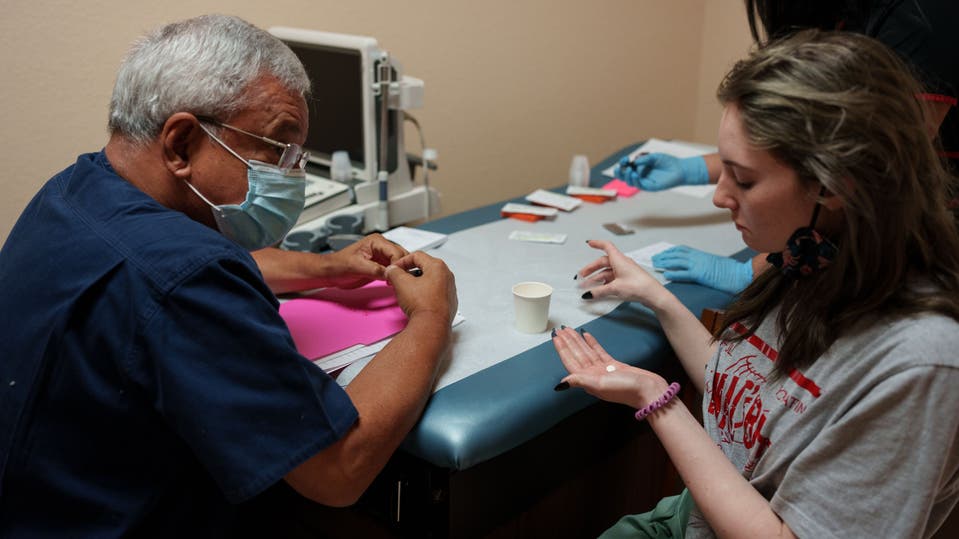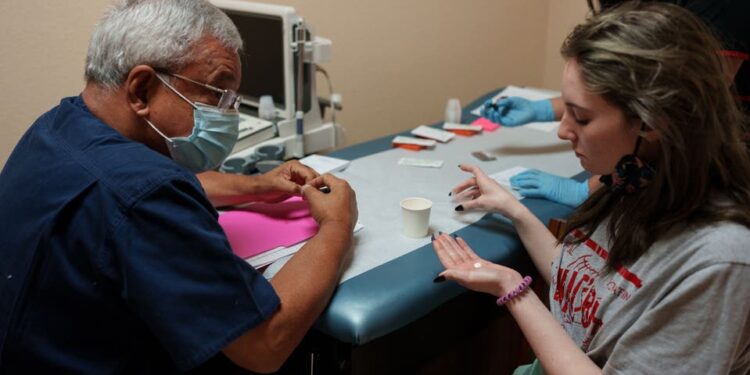
Picture: Paul Ratje
Since the U.S. Supreme Court eliminated the right to abortion at the national level, laws in individual states have become more and more extreme. The consequences can be clearly seen in clinics in New Mexico, where women from Texas and elsewhere are going for help.
At first glance, it looks like a typical American shopping area – a driving school here, a sandwich store there, all with the flat-faced adobe buildings so typical in New Mexico. Only with a closer look is it clear that a woman is sleeping in her car in front of building number 11, which is painted bright yellow. An assortment of signs have been scattered around as well. «Pregnant? Need help?» one says, with the telephone number of a local Catholic church underneath.
Inside, several patients are sitting in the waiting room. Plastic flowers decorate the corners, and the walls are hung with photographs of Indigenous women. Nobody speaks. Every now and then the doctor’s assistant calls out a number – names are taboo here, as everyone wants to remain anonymous.
«Who is the sperm donor?» asks the doctor
Patient Four is lying on the table in the windowless examination room. She has pulled her T-shirt halfway up, and the doctor is pressing the ultrasound probe against her lower abdomen. «Maybe six and a half, seven weeks,» mumbles Franz Theard, the facility’s doctor. He is wearing a white goatee and glasses, his soft brown eyes twinkling behind the lenses. Theard has turned the screen so that the patient doesn’t have to look at it if she doesn’t want to.
Patient Four isn’t looking. She is 27 years old, a petite woman of Hispanic descent with long hair. She has a 15-month-old daughter at home, she says, and during the day she works as a nurse in the intensive care unit. «Ah, so a real nurse,» jokes Theard, and asks almost casually about the «sperm donor,» as he puts it. «My husband!» laughs the patient. She says they have decided together that now is not the right time for a second child, given that she is about to be promoted to the head of her nurses’ station. As Theard congratulates her, the doctor’s assistant is already preparing the medication: one pill today to induce the abortion, four more tomorrow to ensure that the body rejects the embryo, plus antibiotics and painkillers.
Before the patient swallows the first tablet, Theard looks deep into her eyes. «Sweetheart,» he says. «Never tell anyone you’ve had an abortion.» The woman looks at him silently and nods. «Not your general practitioner, not your gynecologist. If anyone asks, you had a miscarriage.»
This is Theard’s most important message to his patients on this day: to the mother of two, aged 40, who feels too old to have another baby. To the restaurant server who is already raising a child on her own. To the military nurse, who is sometimes deployed to war zones. Officially, none of them have ever been here, as Theard tells them. It would be best if they didn’t even mention that they have been away. This is because all these patients come from Texas – where abortion is a criminal offense.

Picture: Paul Ratje

Picture: Paul Ratje
A campaign issue
Few questions dominate American politics at the moment as much as the issue of whether should be allowed to terminate a pregnancy, and at what point. The topic has divided society for decades, but two years ago, it flared up dramatically. In June 2022, the Supreme Court overturned the landmark Roe v Wade ruling, and with it the constitutional right to abortion. Since then, abortion rights have once again been granted or taken away at the discretion of individual states.
The court ruling prompted an outcry across the United States – for some, out of joy, and for others out of indignation. In polls, around two-thirds of Americans say abortions should be allowed in virtually all circumstances. One-third think they should almost always be banned. In this year’s presidential election campaign, abortion is one of the most important issues for many voters, alongside the economy and migration .
When does a life begin? For how long can a woman still say no a pregnancy? Who gets to make decisions about her body – and therefore her future? These are fundamental questions to which many Western countries have long since found answers. But not the United States. This has created a volatile political situation, as abortions are among the most common medical procedures. Around one in four U.S. women of childbearing age terminates a pregnancy in the course of her life.
Abortion regulations in the U.S. could not be more different today. They resemble a patchwork quilt of violently contrasting colors.
In 18 states, abortions are today either banned completely or from the sixth week onward – a point at which many women have not yet even realized they are pregnant. Exceptions, such as when the mother’s life or health is at stake, are very few. In many places, women are not allowed to have abortions even in cases of rape.

Picture: Paul Ratje

Picture: Paul Ratje
In 26 progressive states, on the other hand, abortions are today permitted up to the 24th week or later, even if it is not a case of medical necessity. This is much more permissive than in Switzerland and Germany.
New Mexico is no man’s land
A trip to New Mexico can help shed light on these extreme differences between the states exist. Politically, New Mexico is progressive. Democratic candidates have won here in seven of the last eight presidential elections. Geographically, it is the fifth-largest U.S. state, and covers an area the size of Poland. Yet it has only 2 million residents, making it one of the most sparsely populated regions in the United States. A driver underway through southern New Mexico will see virtually nothing but rolling desert steppe for hours. It is no wonder that the American government chose this no man’s land for the first atomic bomb test 80 years ago, and that it is still used for missile tests today.
But New Mexico is also an oasis – for all those women from the American South who are looking for an abortion clinic. In the neighboring states of Arizona and Utah, the procedure is permitted only under certain circumstances. In the neighboring states of Oklahoma and Texas, it is banned in almost all situations. In New Mexico, by contrast, abortions are permitted until the 24th week of pregnancy.
Word has gotten around. The number of abortions performed here has exploded like nowhere else in the U.S., tripling in three years to almost 21,000 last year.
New Mexico has its big neighbor Texas, the second-largest state in the U.S., to thank for this. Texas has one of the strictest abortion bans in the country. There are no exceptions, not even in cases of rape or incest, or if the fetus will not be viable after birth. The penalty is a $10,000 fine and two to five years imprisonment per abortion. This is true for anyone who helps with the abortion – even a cabdriver who drives a patient to the clinic.
These harsh rules have come with consequences. Last year, for example, 14,000 Texans traveled to the neighboring state of New Mexico to obtain an abortion. In 2019, just 2,400 did so.

Picture: Paul Ratje

Picture: Paul Ratje
«Doctors in Texas have always had problems with abortions»
New Mexico likes to play the role of a safe haven for women. Colorful posters that line the Interstate 10 highway running between El Paso, Texas, and Las Cruces in southern New Mexico carry a reassuring message in Spanish: «We will respect your decisions about abortions.»
Theard’s practice in the small town of Santa Teresa, a two-minute drive from the westernmost tip of Texas, also seeks to put this motto into practice. Ninety-nine percent of his patients come from the Longhorn State, he says. The 75-year-old has been performing abortions for more than 50 years. Born in Haiti, he came to the U.S. as a teenager, studied medicine and did his military service in El Paso. He opened two practices there in the early 1980s – one solely for abortions, and the other for other gynecological treatments. Otherwise it would have been difficult to get referrals, says Theard, whose Haitian roots are still audible in his voice today. «Doctors in Texas have always had problems with abortions,» he adds.
He says that Texas inspectors routinely burst into his practice unannounced, fining him for minor infractions. At his own expense, Theard was required to give patients pamphlets that contained lies, such as the claim that abortions lead to breast cancer. Doctors like him were targets of public hostility in other ways too, he says. For example, anti-abortion activists threatened him, scrawling «baby murderer» in chalk on the driveway of his family home. The constant stress also contributed to his divorce, he says.
In 2005, Theard opened a third practice in Santa Teresa, New Mexico, a few hundred yards from the Texas border – a fallback option in case Texas one day banned abortions altogether, he notes. In the fall of 2021, this actually happened: Texas passed a state law banning the procedure after the sixth week. Nine months later, the Supreme Court followed suit its decision overturning Roe v Wade. Abortions officially became a matter for the states to decide, and were effectively illegal in Texas. Theard closed his two practices there.
In New Mexico, too, protesters now gather outside his clinic sometimes to try to persuade patients to change their minds. But they are peaceful, and don’t bother him, Theard says. «If they can actually talk a patient out of having an abortion in just a few minutes, then maybe the woman wanted the child after all,» he notes. He also tells his patients that they can change their minds at any time, and that they will get all their money back. «Then I joke: ‹If it’s a boy, you’ll have to call him Franz.›»
In the examination room, Theard knows exactly how to mix jokes and serious questions in order to get a quick picture of the situation. Does the woman really want an abortion? Does the man know – or was the abortion even his idea? Theard pays particular attention to what female soldiers are saying. El Paso hosts a large training base for the military, and rape is «unfortunately quite common,» he says. In such cases, he is gentler.
He performs abortions out of conviction. «If you don’t want to have a baby, you shouldn’t have one,» he says. And yet he tries to spare women the procedure. With each patient, he discusses her method of contraception. Perhaps her partner would consider a vasectomy? He bids them farewell with the words: «We like you very much. But we never want to see you again.»

Picture: Paul Ratje

Picture: Paul Ratje
Eleven-hour drive from Houston
Many of the patients travel from far away and sleep in their cars in the parking lot, as can be seen on this morning. Some drive the 11 hours from Houston – or, like Patient Eight, the seven hours from Albany. This makes the procedure both time-consuming and expensive. The 22-year-old Patient Eight pays $490 for the abortion itself and another $160 for gasoline – a considerable sum for the early-career nurse. But having a child is not an option for her at the moment, the young woman says.
Theoretically, she could also have been prescribed the abortion pills via a telemedicine service. Several nationwide providers send the same tablets that Theard hands out in the office by mail after a video consultation – for a fraction of the price. This route is becoming increasingly popular as a means of circumventing abortion bans in conservative states. However, many women are still unaware of this option, or are unwilling to pursue it. Patient Eight is also afraid of receiving the pills at home through the mail. Aside from her boyfriend, no one around her knows about the pregnancy, she says. Moreover, it would technically be a criminal offense. «The visit here felt safer,» she says in a low voice.
All the patients on this morning are between six and 11 weeks pregnant. Up to this point, they can have an abortion induced with medication of this kind. At later stages, they would have to undergo a surgical procedure. Theard no longer offers this option himself. Following a serious brush with COVID-19, he greatly reduced his working hours, he says. He doesn’t miss this part of his work, he adds. On the contrary: «To be honest, I don’t like surgical abortions,» he says. «It’s not very nice to destroy something and then take it out. Maybe I shouldn’t say that out loud, but it’s the truth.»
Avoiding the word «abortion»
As a result, there is no longer a single doctor in southern New Mexico who performs surgical abortions. Patients now have to travel to Albuquerque, the most populous city in New Mexico, four hours’ drive north of Santa Teresa. The women who do so are usually those whose pregnancies are already at an advanced stage. Statistically speaking, such cases are rather rare: Just under 7% of all abortions in the U.S. take place after the 13th week of pregnancy, according to a 2021 survey by the Centers for Disease Control and Prevention.
In Albuquerque, one place to go is the Center for Reproductive Health at the University of New Mexico. Lisa Hofler, who works there as a gynecologist for high-risk pregnancies, tells us that patients now come from all over the country. She recently received another bizarre call from a professional colleague in a state with an abortion ban, she says. A pregnant woman’s embryo was developing without a skull and without a brain, the caller said, and the patient now needed «a second opinion from New Mexico.» Hofler shakes her head. «Neither the doctor nor the patient dared to utter the word abortion,» she says. «Yet an abortion is the most merciful thing you can do for the patient in such a situation.»
Meanwhile, so many women from other states are flocking here that the Center for Reproductive Health has set up its own coordination office to help women plan their trips. The office also helps them find funding, because the expenses are enormous. An abortion in the advanced stages of pregnancy can cost up to $6,600, with additional funds needed for airline flights, hotel rooms and care for any children that have been left at home. The facility’s coordinator says that when her phone rings, it is usually a desperate woman on the other end of the line. In the vast majority of patients, the pregnancy was originally wanted, but deformities or health risks have forced the women to consider an abortion, she adds. «In addition to the grief, many feel guilty and ashamed that they now have to do something that is forbidden where they live,» the coordinator says.

Picture: Paul Ratje
Many patients communicate with disposable cellphones
Whether they are coming to Albuquerque or Santa Teresa, many of the women seeking abortions are clearly afraid. They frequently communicate with the doctors only via email addresses created solely for this purpose, or by using disposable cellphones. Sometimes they deliberately leave their examination documents in the doctor’s office. About half of Theard’s patients don’t pick up the phone when his assistants call to carry out a follow-up examination. This can be dangerous. In rare cases, abortions induced via medication can produce serious side effects, including septic shock. Sometimes the medication doesn’t work, and the woman remains pregnant.
These fears may seem exaggerated, because legally speaking, abortions are legal as long as they are allowed in the state in which they are performed. But reality is rarely this simple. Many women are already on their way home when they take the second abortion pill, because they want to be at home when the bleeding and cramps begin, a sign that their body is rejecting the embryo. «I advise all my patients not to tell anyone about the abortion,» Theard says. «People will treat them as if they had killed Jesus.»
The patchwork of laws also worries some abortion doctors. A doctor from Massachusetts tells me on the phone that she no longer sets foot in states with abortion bans, even though she has family there. She is too afraid that she could suddenly be forced by the courts to hand over patient data, she says.
Fights over abortion becoming more intense
Given the difficulties, it might be natural to assume that the number of abortions in the United States has now fallen drastically. Yet in fact the opposite is true. According to the Guttmacher Institute, more than 1 million abortions were performed in the U.S. in 2023 – 11% more than in 2020. Experts explain this by noting that many progressive states have expanded their abortion services enormously, especially via telemedicine. This has more than compensated for the decline in conservative states. In these latter states, a different trend is emerging: The number of unintended births has recently gone up significantly, as a recently published study shows – in Texas, for example, by a remarkable 5.1%.
The fight over abortion bans is becoming more and more extreme. Anti-abortion activists are now trying to have the Mifepristone abortion pill banned nationwide. Experts agree that if they achieve this, it would have even more dramatic effects than the overturning of Roe v Wade. And in conservative Alabama, the state Supreme Court recently ruled that cryopreserved embryos should be classified as human life. As a result, several clinics have paused this form of fertility treatment.
Those on the other side of the debate advocate the opposite extreme: a nationwide right to abortions, at any point in the pregnancy, without any reason necessary.
After 50 years on the front lines of this dispute, Theard would like to retire and make way for a successor, he says. But the 75-year-old can’t find anyone to take over his practice. «Most abortion doctors are now as old as I am. We simply can’t motivate young people,» he says. «They would rather have nothing to do with this issue.»
Latest articles
Global reporting. Swiss-quality journalism.
In today’s increasingly polarized media market, the Switzerland-based NZZ offers a critical and fact-based outside view. We are not in the breaking-news business. We offer thoughtful, well-researched stories and analyses that go behind the headlines to explain relevant events in the U.S., in Europe and worldwide. To produce this work, the NZZ maintains an industry-leading network of expert reporters around the globe who work closely with our main newsroom in Zurich.
Sign up for our free newsletter or follow us on Twitter, Facebook or WhatsApp.
Source link : http://www.bing.com/news/apiclick.aspx?ref=FexRss&aid=&tid=66e2fc12105c4591a1ee4015730819ee&url=https%3A%2F%2Fwww.nzz.ch%2Fenglish%2Fnew-mexico-is-safe-haven-for-us-women-seeking-abortions-ld.1847914&c=15940996808744820693&mkt=en-us
Author :
Publish date : 2024-09-11 12:59:00
Copyright for syndicated content belongs to the linked Source.







